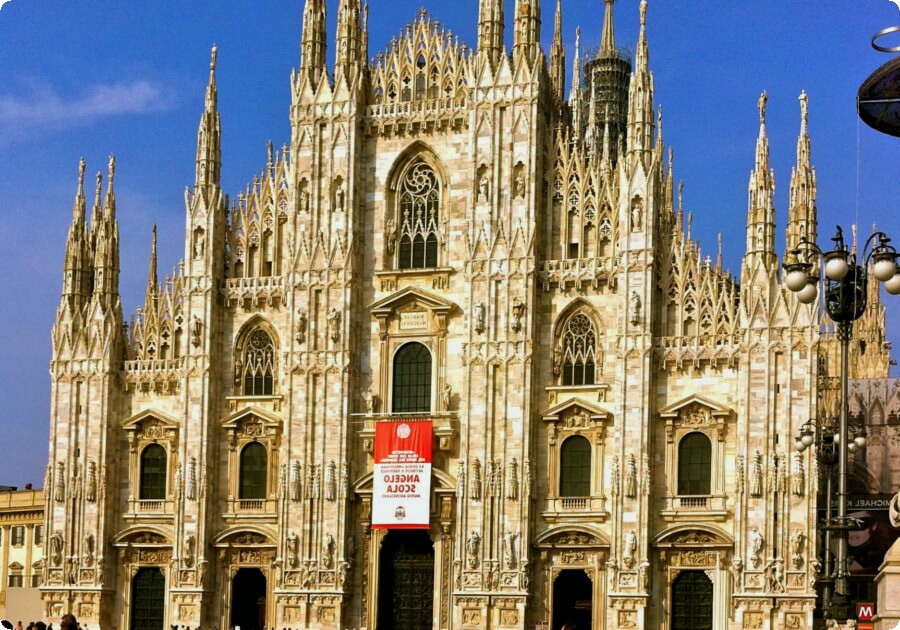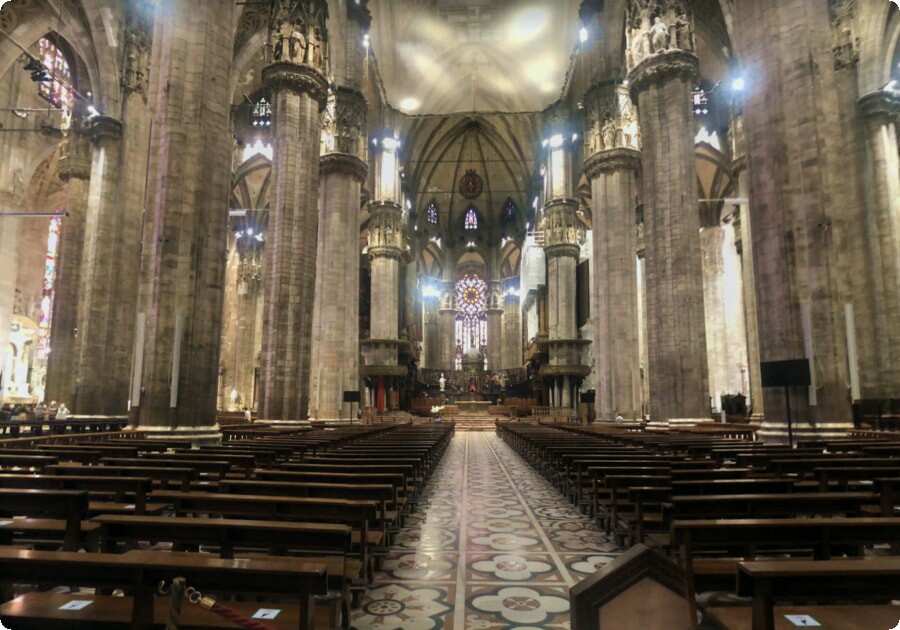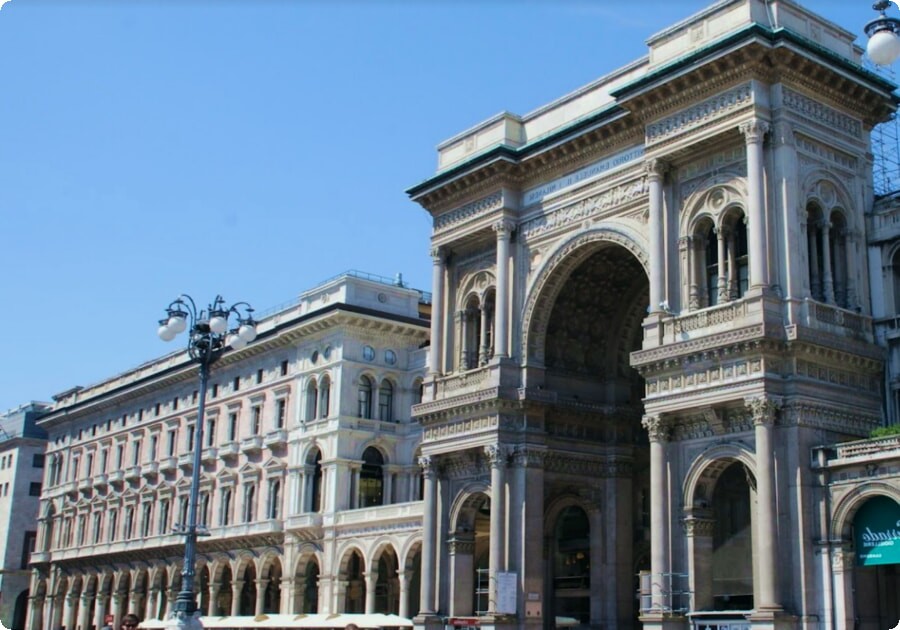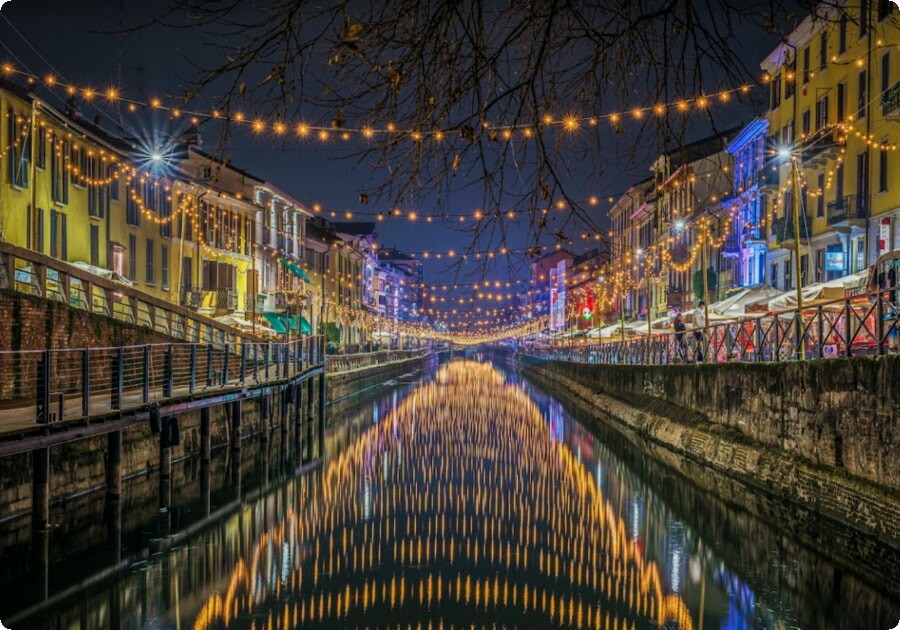Notable Places Around Milan
Milan is a great place to stop for a few days, but if you have time for more day trips, there are plenty of pretty towns and villages dotted throughout the surrounding region.
Spend a few hours in the scenic Alpine scenery of Interlaken, sample world-famous Swiss chocolate in Lugano, or explore a cluster of pretty islands on Lake Maggiore. Alternatively, you can take the ferry to the nearby Cinque Terre, or head east and visit Verona, Shakespeare’s fair city, which is only a two-hour drive away from Milan.
The Duomo
The Duomo is a must-see when visiting Milan. This historic building is known for its impressive spires and stunning interior design. The building is a major tourist attraction and attracts many visitors from all over the world each year.
The cathedral is the fourth largest in the world and features a dome by Filippo Brunelleschi. It was first constructed in the 13th century and the famous spire was added in the 15th century. It was originally designed by Arnolfo di Cambio and is a masterpiece of Gothic architecture.
Inside the cathedral there are several important paintings and sculptures that should be seen. One of these is a painting called 'Dante and the Divine Comedy' by Domenico di Michelino, painted in 1465 to commemorate the 200th anniversary of Dante's birth.
Another popular painting is 'The Holy Family in the Temple' by Lorenzo da Modena. This painting is located in the central nave and depicts a scene from the life of Jesus.
There are also beautiful stained-glass windows, such as 'The Adoration of the Shepherds' by Giotto. These are worth seeing as they have a unique style that is often compared to works by Raphael and Botticelli.
You can also visit the Museo dell'Opera del Duomo, which has more than one thousand works of art. You can see pieces by such great artists as Michelangelo and Donatello, among others.
For those who want to experience the beauty of this landmark without a crowd, there are guided tours that can be booked online. Those who book online have the opportunity to get up close to some of these amazing art pieces and learn more about the history of this iconic building.
It is also possible to climb the Campanile which has a total of 400 steps and a height of 85 meters. The climb takes about 45 minutes and can be done from 8:15 a.m to 7:45 p.m every day of the week.
The Duomo is closed on Sundays and key religious days such as Easter. You can also enjoy a tour of the crypt, which is home to the tombs of Brunelleschi and Santa Reparata.
For those who like to travel around Italy by car, there is an opportunity to get a rental car in all popular locations in Italy: at the main railway stations, in the city center, at the nearest airports. Tariffs may vary depending on various factors: the duration of the rental, the class of the car, the place where the car was received. For example, in Milan t you can rent a compact class car from 18 euros per day, and at Malpensa Airport from 17 euros per day.

San Babila
A landmark in the city, the Collegiate Prepositural Basilica of San Babila, located right in the centre, is one of the most important churches in Milan. It has a thousand-year history, and has played a major role in the religious and civic movements that originated here.
The church has a large and impressive façade, with a front colonnade of 36 imposing columns. It is a neoclassical structure, reminiscent of the Roman Pantheon. In the interior, there is an exquisite Zanin pipe organ.
Another highlight is the Piazza San Babila, a square that has a large fountain. It is designed in a pyramidal shape and is made of granite from the mountains near Milan. It is considered one of the most significant squares in Italy.
Among the most famous buildings in this area is the Palazzo Visconti di Modrone, a 17th century palace that has been restored to its former glory. It is a unique and elegant place to hold private events, such as weddings and concerts.
You can also find many modern theaters in this area, such as the Teatro alla Scala and the Teatro Manzoni. These are all examples of how the city has evolved over time, and they have become iconic in the cityscape.
In the same vicinity you can find several upscale shopping streets, such as Corso Venezia and Via Montenapoleone. There are some great designer shops here as well, and you can find the latest trends in Milanese fashion.
This is a very lively area and you may want to take your time and explore it carefully. You will be able to find numerous boutiques, antiques and elegant restaurants.
Some places to look out for are the elegant Martini Bistro by Dolce & Gabbana, which is located in the Galleria San Babila at 4/b, and the historic Gin Rosa bar, which is on Corso Matteotti 14. It offers a gin and orange peel cocktail that has been a staple of Milanese culture since 1820.
You can also stay at Brera Prestige B&B, a luxury accommodation in Milan city center that is just a 10-minute walk from the Cathedral Square. It offers free WiFi and rooms with air conditioning.

Naviglio Grande
Whether you’re looking for a romantic escape, a great place to walk with the kids or somewhere to sample some of the best Milanese cuisine, the Navigli district has you covered. From the iconic red bridges to a booming bar scene and hip boutiques, the area is a haven of activity for locals and visitors alike.
The Naviglio Grande canal is one of the oldest and most well-known of all Milan’s waterways. It was constructed during the 12th century, and has a history as one of the city’s most important navigation routes, acting as both an irrigation system and transport link for seven centuries.
As you travel along the canal, you can see historic buildings and quaint secret courtyards. You’ll also find plenty of bars and cafes, as well as a number of stalls selling trinkets and souvenirs.
You can even take a dip in the canal if you wish. It’s a beautiful, relaxing spot to enjoy the sun reflected in the waters and the bustle of the area below.
Unlike the other major canals in the city, the Naviglio Grande has been a popular tourist attraction since its construction, with its narrow streets lined with pubs, restaurants and historical buildings. There’s also a lively street market and a stunning church in the district.
It’s worth stopping at the Darsena, an old shipyard that used to serve as a central trading hub for eight centuries until it was decommissioned during the rapid urbanisation of the 1960s. Once an overgrown swamp, the Darsena now functions as a focal point for nightlife in the city, with cafes, bars and local businesses filling its now-thriving urban lagoon.
Another great way to explore the Navigli district is on a guided walking tour. Your guide will lead you through the area’s narrow lanes, stopping at a range of bars to sample a variety of drinks and try some local delicacies.
This is a fantastic way to experience some of the best places in the area, including many hidden gems that you’d otherwise miss! Plus, it’s a great opportunity to get to know the local culture.

Porta Ticinese
One of the more notable places around Milan is Porta Ticinese, which is a former city gate located on Piazza XXIV Maggio. The gate, which dates back to the 16th century, was rebuilt in the 19th century with a neoclassical design.
The structure is an example of philological restoration, which is the practice of renovating and restoring monuments to their original appearance. This was an important method in Milan during the 19th century, and it was codified by Camillo Boito, who argued that all monuments, from fortifications to statues, should be equally protected.
In addition to the neoclassical Porta Ticinese, there are many other historical buildings and landmarks in this area. These include the Basilica di San Lorenzo Maggiore, with its 4th-century origins; and the Basilica di Sant’Eustorgio, which contains frescoes by Renaissance artist Vincenzo Foppa.
If you’re looking for things to do in this area, there are plenty of options. The district is a popular destination for students and hipsters, who can find low-key trattorias, dive bars and late-night hangouts, as well as vinyl and vintage shops, stylish pop-up businesses and tattoo parlors.
This part of the Centro Storico district is one of the liveliest in the city, and it’s also home to one of Milan’s main shopping streets, Via Torino. The Corso di Porta Ticinese street connects Colonne di San Lorenzo to Piazza XXIV Maggio, where there are a number of restaurants and cafes.

There is a wide range of activities in the area, and there are several parks and open spaces to enjoy. These include the Parco Sempione and the Parco Solari, which are great for walking.
Another popular spot in this area is the Navigli district, which is home to a number of canals and is known for its nightlife. The area is bustling with bars and restaurants that stay open late into the night, so it’s an excellent choice if you’re looking for somewhere to go dancing or drinking after dinner.
The Navigli area is an extremely romantic place to visit in Milan. It is a charming neighborhood that features tree-lined streets and old banisters, which offer a partial view of the city. You can also enjoy a number of museums and churches that are well worth exploring.